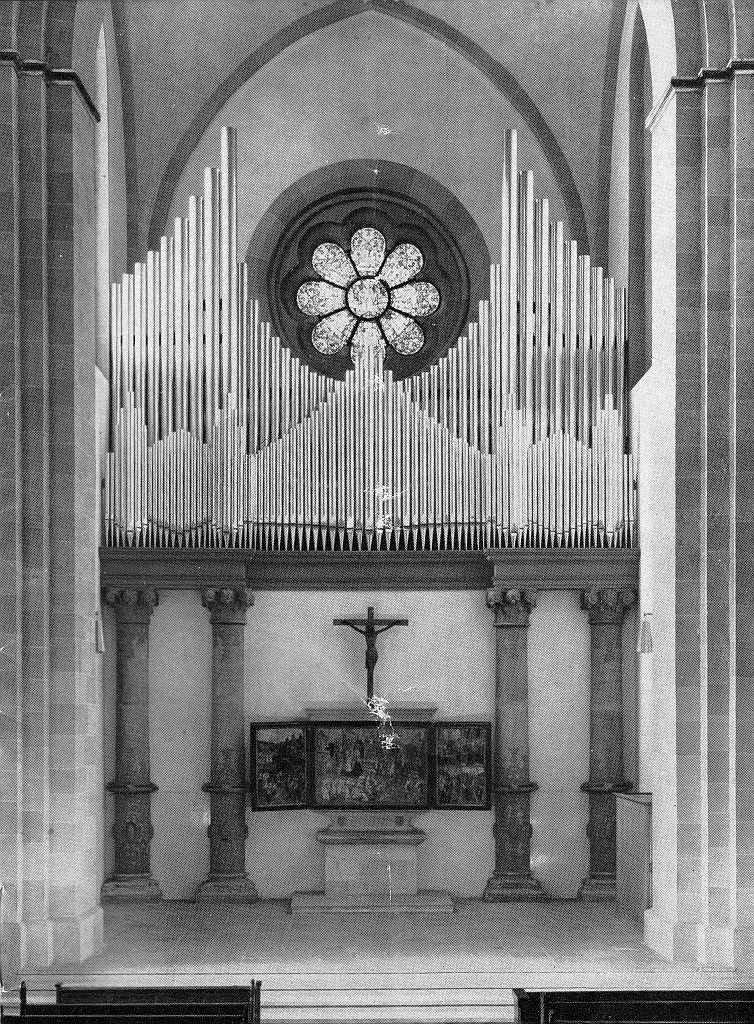Ausführliche Beschreibung der vorgewählten Orgel

Paderborn, Deutschland (Nordrhein-Westfalen) - Hohen Domkirche Sankt Liborius, Turmorgel
Gemeinde: Paderborn
Region:Westfalen
Adresse: Domplatz 3, 33098, Paderborn
Website: https://www.dom-paderborn.de/
Beschreibung nr.: 2068409.
Gebaut von: Anton Feith jr. (1959)
Replaced (1980)
Technische Daten
Disposition
I. Manual (C-g'''): Großprinzipal 16', Oktave 8', Spitzgamba 8', Grobgedackt 8', Großquinte 5 1/3', Oktave 4', Hohlflöte 4', Superoktave 2', Rauschquinte 3 fach, Mixtur 5-6 fach, Scharff 4 fach, Trompete 16', Trompete 8'.
II. Manual (C-g'''): Rohrflöte 8', Quintadena 8', Singend Prinzipal 4', Spitzflöte 4', Flachflöte 2', Quinte 1 1/3', Sesquialter 2 fach, Scharff 4 fach, Dulcian 16', Schalmey 8'.
III. Manual (Schwellwerk) (C-g'''): Gedacktpommer 16', Holzprinzipal 8', Zartgedackt 8', Weidenpfeife 8', Schwebung 8', Oktave 4', Koppelflöte 4', Gemsquinte 2 2/3', Oktave 2', Terzflöte 1 3/5', Waldflöte 1 1/3', Sifflöte 1', Mixtur 5-6 fach, Trompette Harmonique 8', Oboe 8', Clairon 4'.
IV. Manual (C-g'''): Rohrquintade 8', Lieblich Gedackt 8', Querflöte 4', Prinzipal 2', Schweizerpfeife 1', Septime 4/7', Echokornett 3 fach, Zymbel 3 fach, Trichter-Dulcian 8', Geigend Regal 4'.
Pedal (C-f'): Prinzipal 16', Weitgedackt 16', Gedacktbaß 16', Oktave 8', Gemshorn 8', Choralbaß 4', Baßflöte 4', Nachthorn 2', Mixtur 6 fach, Bombarde 32', Posaune 16', Baßtrompete 8', Clarine 4', Singend Kornett 2'.

Paderborn, Deutschland (Nordrhein-Westfalen) - Hohen Domkirche Sankt Liborius, Turmorgel
Gemeinde: Paderborn
Region:Westfalen
Adresse: Domplatz 3, 33098, Paderborn
Website: https://www.dom-paderborn.de/
Beschreibung nr.: 2068409.
Gebaut von: Anton Feith jr. (1959)
Replaced (1980)
- The Domkirche in Paderborn was restored in the years 1924-1926. The organ builder A. Feith from Paderborn built three new organs for the church at the same time, a main organ on the tower wall with 66 stops, a choir organ with 33 stops and a crypt organ with 11 stops. All three instruments received a facade with an open pipe arrangement. There were three consoles, but all organs could be played from the choir organ's console. In 1945, the main and choir organ were completely destroyed by bombing. The crypt organ was partially preserved.
- In the years 1949-1951 a new choir organ with 43 stops was built and in the years 1958-1959 a new main organ with 63 stops, both by Anton Feith. The main organ was consecrated on December 13, 1959. The crypt organ was restored in 1971 and expanded to 15 stops. The instruments also did not have an organ case, an open front and electro-pneumatic cone chests.
- The church building was completely restored in the years 1977-1981. The company Siegfried Sauer was then commissioned to revise the three organs, largely to rebuild them, and to link them together. A large part of the material by Feith was re-used in the new instruments.
Technische Daten
| Anzahl Register pro Manual | |
| - I. Manual | 13 |
| - II. Manual | 10 |
| - III. Manual (Schwellwerk) | 16 |
| - IV. Manual | 10 |
| - Pedal | 14 |
| Gesamtzahl der Stimmen | 63 |
| Tastentraktur | Electrical |
| Registertraktur | Electrical |
| Windlade(n) | Slider chests |
Disposition
I. Manual (C-g'''): Großprinzipal 16', Oktave 8', Spitzgamba 8', Grobgedackt 8', Großquinte 5 1/3', Oktave 4', Hohlflöte 4', Superoktave 2', Rauschquinte 3 fach, Mixtur 5-6 fach, Scharff 4 fach, Trompete 16', Trompete 8'.
II. Manual (C-g'''): Rohrflöte 8', Quintadena 8', Singend Prinzipal 4', Spitzflöte 4', Flachflöte 2', Quinte 1 1/3', Sesquialter 2 fach, Scharff 4 fach, Dulcian 16', Schalmey 8'.
III. Manual (Schwellwerk) (C-g'''): Gedacktpommer 16', Holzprinzipal 8', Zartgedackt 8', Weidenpfeife 8', Schwebung 8', Oktave 4', Koppelflöte 4', Gemsquinte 2 2/3', Oktave 2', Terzflöte 1 3/5', Waldflöte 1 1/3', Sifflöte 1', Mixtur 5-6 fach, Trompette Harmonique 8', Oboe 8', Clairon 4'.
IV. Manual (C-g'''): Rohrquintade 8', Lieblich Gedackt 8', Querflöte 4', Prinzipal 2', Schweizerpfeife 1', Septime 4/7', Echokornett 3 fach, Zymbel 3 fach, Trichter-Dulcian 8', Geigend Regal 4'.
Pedal (C-f'): Prinzipal 16', Weitgedackt 16', Gedacktbaß 16', Oktave 8', Gemshorn 8', Choralbaß 4', Baßflöte 4', Nachthorn 2', Mixtur 6 fach, Bombarde 32', Posaune 16', Baßtrompete 8', Clarine 4', Singend Kornett 2'.
| Literatur |
|
 |
